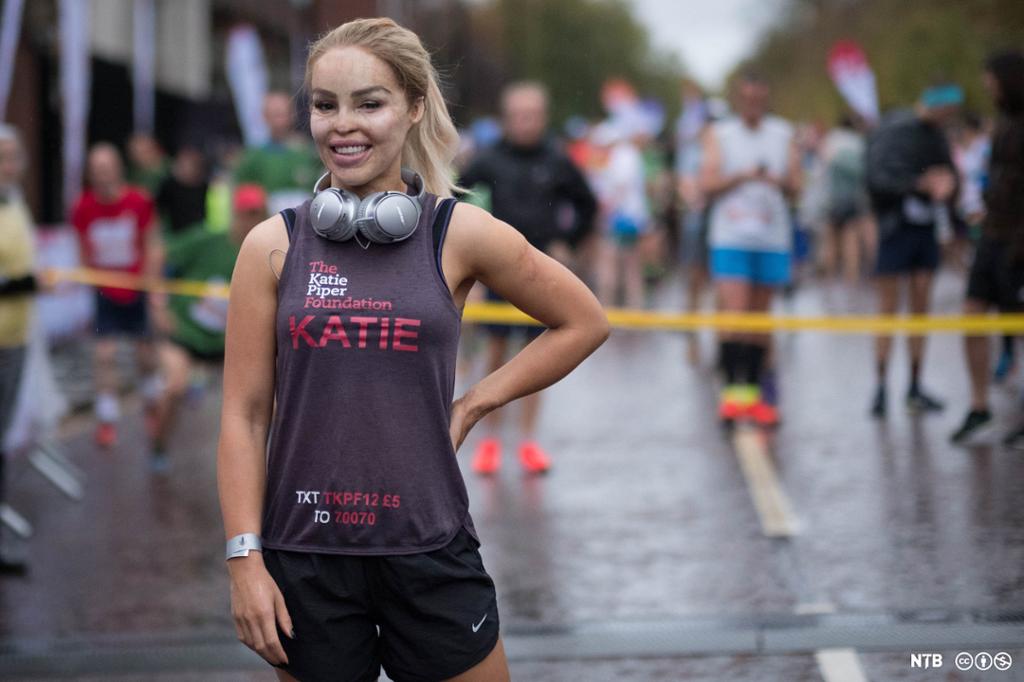Excerpt: Katie Piper, Super Role Model by Richard Reed

It’s a sunny afternoon in London and I’m in a posh bar drinking G&Ts with the gorgeous model, TV presenter, philanthropist and best-selling author Katie Piper. It’s a tough life.
Over the drinks, I learn many remarkable things about my cocktail buddy: the thousands of people she has helped with her charity; her prolific output as a writer, publishing five books in just eight years; her ability to juggle her many work commitments with the demands of being a parent. And the most remarkable thing of all, her approach to life since the day, eight years ago, when she was raped by her ex-boyfriend and had sulphuric acid thrown in her face.
It was an attack designed to do as much physical harm as possible and in that regard it was horribly successful. After waking from an induced twelve-day coma her doctor explained the situation, which in summary was: you’re blind in both eyes, you have no face left, you’re struggling to breathe because you’ve swallowed your oesophagus and the police are here to video you in case you don’t survive until the trial.
Her immediate response was simple and understandable: –I just thought to myself, "I’ll do whatever I need to do to get discharged and then quietly go home, take an overdose and kill myself." The following weeks passed slowly: bedridden, in pain, unable to move, with a nurse present twenty-four hours a day, Katie would silently plan her suicide. But one night when thinking about how to do it, – something, somewhere said to me: "Don’t kill yourself. I can’t tell you why, but there’s a bigger reason. You have to stay alive." In that moment, she says, she made what became the most important decision of her life: she chose to be a survivor, not a victim.
That resolve hardened when the time came to be discharged from hospital. She praises the brilliant care she received from the nurses and doctors looking after her, but when people started talking about disability benefits and council flats, she realised just how low expectations were of what her life would become. – No one said a disfigured woman can still get married, have babies, be sexy, be a CEO, be a trailblazer, be a leader in fashion. So I decided to go out there and reach for everything I wanted. As far as everyone else was concerned I had nothing to lose anyway.
Part of the recipe of building her new life was acceptance of what had happened. – I said to myself, I’m never going to look like the old me or Cindy Crawford, but maybe I could be my own kind of beautiful. Another part was sheer resilience. – If you look around at all the things that have been achieved, they were usually done by people told there was no hope at all, but they carried on plugging away regardless. I took inspiration from that. And of course there was a huge degree of bravery, of enduring more than forty operations and 100 skin grafts, of withstanding wearing a mask twenty-three hours a day, of facing the outside world again for the first time. – In the early days I didn’t want to leave the house, I was really agoraphobic, they were dark times. But there came a point where I’d been watching Loose Women for a year, wearing pyjamas, and I needed to get out.
As a single woman who aspired to get married and start a family there was also the world of dating to tackle. – I was living in a one-bed flat in Chiswick in a plastic face mask just trying to get someone to text back, and I thought OK, for all my positivity, this is quite difficult, no one is going to fancy me. But she wasn’t going to let her disability get in the way of what she wanted – to be a mother. – I started putting money aside to freeze my eggs and started researching how to adopt a child because as far as I was concerned nothing was going to stop me becoming a mum. In the end she kept going with the dating and did meet a guy, fall in love, get married and have a child. And there are the glamorous Hello! features to prove it.
Katie Piper says people typically just assume disabilities put you at a disadvantage, but she wasn’t prepared to accept that. – People assumed my life was over. I didn’t. On paper I should have less opportunities and be unhappy. I should be clinically depressed and dependent on alcohol. But I’ve never been more positive, and I’ve never attracted so many positive, successful people into my life.
Those things people automatically thought would no longer apply to her – getting married, becoming a mum, returning to modelling, running a charity, helping thousands of other burn sufferers – she’s done all of them and more. The insight she’s got from these achievements and her experience over the last eight years inform her best piece of advice:
– The whole thing has taught me that the barriers we put before ourselves don’t really exist. The only way barriers exist is in our heads. We create them, we feed them, and we choose to keep them alive. So we can also choose to break them down. Confidence and happiness are not luck or something only other people can have, they are decisions you make that involve hard work, commitment and believing that you actually deserve it. There are no barriers to stop you getting them. And if for whatever reason you ever feel in despair, it is worth remembering God gives his toughest journeys to his strongest soldiers.
Copyright © Richard Reed,
Canongate Books.
Relatert innhold
Tasks related to the interview with Katie Piper.